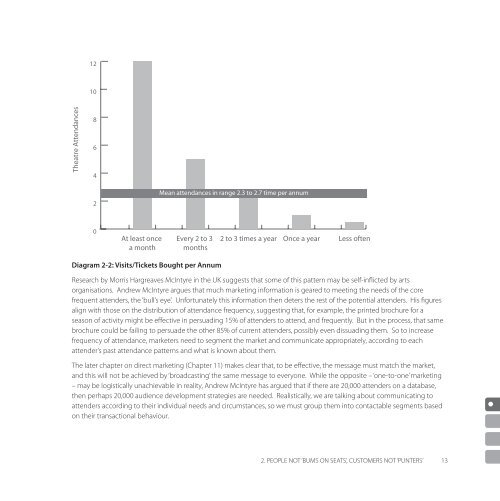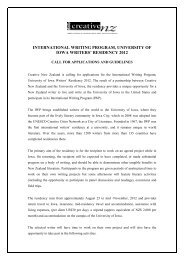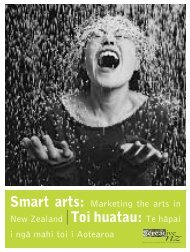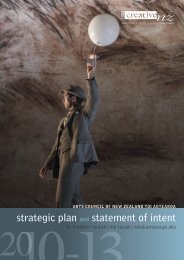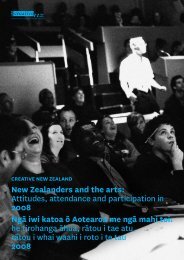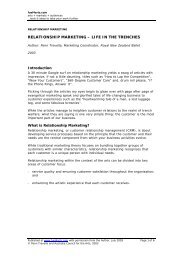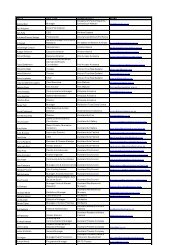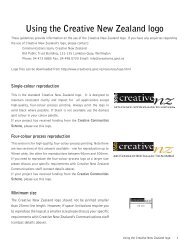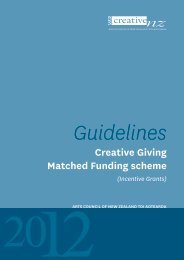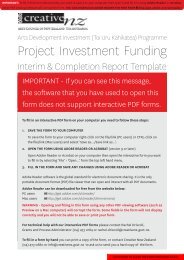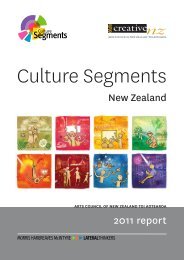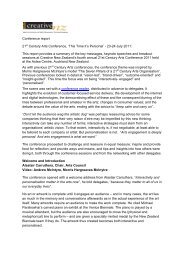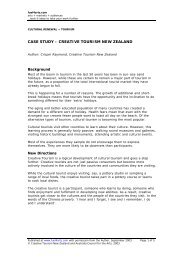FULL HOUSE Turning Data into Audiences - Creative New Zealand
FULL HOUSE Turning Data into Audiences - Creative New Zealand
FULL HOUSE Turning Data into Audiences - Creative New Zealand
You also want an ePaper? Increase the reach of your titles
YUMPU automatically turns print PDFs into web optimized ePapers that Google loves.
12<br />
10<br />
Theatre Attendances<br />
8<br />
6<br />
4<br />
2<br />
Mean attendances in range 2.3 to 2.7 time per annum<br />
0<br />
At least once<br />
a month<br />
Every 2 to 3<br />
months<br />
2 to 3 times a year<br />
Once a year<br />
Less often<br />
Diagram 2-2: Visits/Tickets Bought per Annum<br />
Research by Morris Hargreaves McIntyre in the UK suggests that some of this pattern may be self-inflicted by arts<br />
organisations. Andrew McIntyre argues that much marketing information is geared to meeting the needs of the core<br />
frequent attenders, the ‘bull’s eye’. Unfortunately this information then deters the rest of the potential attenders. His figures<br />
align with those on the distribution of attendance frequency, suggesting that, for example, the printed brochure for a<br />
season of activity might be effective in persuading 15% of attenders to attend, and frequently. But in the process, that same<br />
brochure could be failing to persuade the other 85% of current attenders, possibly even dissuading them. So to increase<br />
frequency of attendance, marketers need to segment the market and communicate appropriately, according to each<br />
attender’s past attendance patterns and what is known about them.<br />
The later chapter on direct marketing (Chapter 11) makes clear that, to be effective, the message must match the market,<br />
and this will not be achieved by ‘broadcasting’ the same message to everyone. While the opposite – ‘one-to-one’ marketing<br />
– may be logistically unachievable in reality, Andrew McIntyre has argued that if there are 20,000 attenders on a database,<br />
then perhaps 20,000 audience development strategies are needed. Realistically, we are talking about communicating to<br />
attenders according to their individual needs and circumstances, so we must group them <strong>into</strong> contactable segments based<br />
on their transactional behaviour.<br />
2. PEOPLE NOT ‘BUMS ON SEATS’, CUSTOMERS NOT ‘PUNTERS’<br />
13


